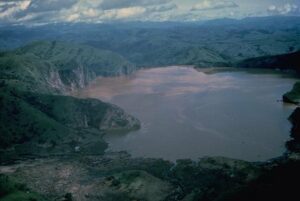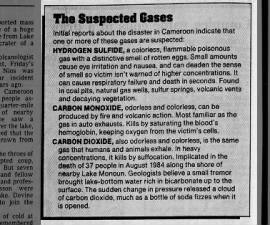
Lake Nyos, 1986
On August 21, 1986, a rare natural disaster occurred in the West African country of Cameroon when a large cloud of carbon dioxide gas erupted from Lake Nyos (Nios), a deep volcanic crater lake.
Background
The event, known as a limnic eruption, occurs when carbon dioxide (CO2) builds in colder, deep lake water, creating a layer on the bottom. The weight of the warmer, upper layer of water forms a lid that keeps the gas down. When these layers are disturbed, an eruption of carbon dioxide occurs.
Lake Nyos Eruption
On August 21, 1986, the built-up gases in Lake Nyos (caused by a pocket of magma beneath the lakebed) were released, resulting in a massive eruption that created a 330-foot-high column of water and a cloud of carbon dioxide gas 160 feet thick.
The carbon dioxide blanketed nearby villages, suffocating nearly 1,800 people and about 3,500 livestock; others fell unconscious. After the eruption, the blue appearance of the lake turned red-brown due to oxidation of the iron-rich water.
Causes
Initially, scientists were unsure what type of gas had caused the disaster, but carbon dioxide was soon identified. As for what triggered the eruption, many researchers concluded that an underwater landslide had likely disrupted the layers and caused the gases to bubble up. Others, however, theorized that a small volcanic eruption below the lake caused the release. Additional hypotheses exist as well.
Prevention Efforts
After the 1986 disaster, carbon dioxide continued accumulating in Lake Nyos. In order to prevent a future limnic eruption, scientists started venting the gas with a large pipe in 2001 and added two more in 2011. When lowered to the bottom, these degassing tubes perform like big straws—sucking the gas upward, where it is vented gradually into the air.
Learn more about the Lake Nyos Disaster through historical newspapers from our archives. Explore newspaper articles, headlines, images, and other primary sources below.
Articles and Clippings about the Lake Nyos Disaster
 "Volcanic gas kills 40"; early article in Canadian newspaper about Lake Nyos disaster Sun, Aug 24, 1986 – 3 · Calgary Herald (Calgary, Alberta, Alberta, Canada) · Newspapers.com
"Volcanic gas kills 40"; early article in Canadian newspaper about Lake Nyos disaster Sun, Aug 24, 1986 – 3 · Calgary Herald (Calgary, Alberta, Alberta, Canada) · Newspapers.com "'The People Were Sleeping' as Volcano Gas Killed 1,200; 5 Nations Rush Aid to Cameroon" Mon, Aug 25, 1986 – 1 · The Los Angeles Times (Los Angeles, California) · Newspapers.com
"'The People Were Sleeping' as Volcano Gas Killed 1,200; 5 Nations Rush Aid to Cameroon" Mon, Aug 25, 1986 – 1 · The Los Angeles Times (Los Angeles, California) · Newspapers.com "Volcanic lake's toxic gas kills 2,000 in Cameroon" (with map) Mon, Aug 25, 1986 – 1 · The Bismarck Tribune (Bismarck, North Dakota) · Newspapers.com
"Volcanic lake's toxic gas kills 2,000 in Cameroon" (with map) Mon, Aug 25, 1986 – 1 · The Bismarck Tribune (Bismarck, North Dakota) · Newspapers.com List of "suspected gases" in Cameroon Lake Nyos disaster Tue, Aug 26, 1986 – 52 · The Miami Herald (Miami, Florida) · Newspapers.com
List of "suspected gases" in Cameroon Lake Nyos disaster Tue, Aug 26, 1986 – 52 · The Miami Herald (Miami, Florida) · Newspapers.com "Cameroon gas disaster; Africans likely suffocated by cloud of carbon dioxide" Tue, Aug 26, 1986 – 5 · Austin American-Statesman (Austin, Texas) · Newspapers.com
"Cameroon gas disaster; Africans likely suffocated by cloud of carbon dioxide" Tue, Aug 26, 1986 – 5 · Austin American-Statesman (Austin, Texas) · Newspapers.com "Cameroon Gas Toll Put at 1,200; Traces of Toxic Cloud Remain, Evacuation Goes On, Regime Says" Tue, Aug 26, 1986 – 18 · The Los Angeles Times (Los Angeles, California) · Newspapers.com
"Cameroon Gas Toll Put at 1,200; Traces of Toxic Cloud Remain, Evacuation Goes On, Regime Says" Tue, Aug 26, 1986 – 18 · The Los Angeles Times (Los Angeles, California) · Newspapers.com "Quake or landslide may've triggered deadly gas" in Cameroon's Lake Nyos eruption Wed, Aug 27, 1986 – 4 · The Central New Jersey Home News (New Brunswick, New Jersey) · Newspapers.com
"Quake or landslide may've triggered deadly gas" in Cameroon's Lake Nyos eruption Wed, Aug 27, 1986 – 4 · The Central New Jersey Home News (New Brunswick, New Jersey) · Newspapers.com "Mass burials start for 1,500 killed by mysterious gas in Cameroon" Wed, Aug 27, 1986 – Page 11 · Arizona Republic (Phoenix, Arizona) · Newspapers.com
"Mass burials start for 1,500 killed by mysterious gas in Cameroon" Wed, Aug 27, 1986 – Page 11 · Arizona Republic (Phoenix, Arizona) · Newspapers.com "View of Cameroon Disaster: Gas Deaths Like 'a Neutron Bomb'" Wed, Aug 27, 1986 – 93 · The Los Angeles Times (Los Angeles, California) · Newspapers.com
"View of Cameroon Disaster: Gas Deaths Like 'a Neutron Bomb'" Wed, Aug 27, 1986 – 93 · The Los Angeles Times (Los Angeles, California) · Newspapers.com "Empty villages, rotting carcasses are all that's left in wake of volcanic cloud" from Lake Nyos Wed, Aug 27, 1986 – 22 · The Bismarck Tribune (Bismarck, North Dakota) · Newspapers.com
"Empty villages, rotting carcasses are all that's left in wake of volcanic cloud" from Lake Nyos Wed, Aug 27, 1986 – 22 · The Bismarck Tribune (Bismarck, North Dakota) · Newspapers.com "Cameroon receiving supplies" following Lake Nyos disaster Thu, Aug 28, 1986 – 11 · The Herald-News (Passaic, New Jersey) · Newspapers.com
"Cameroon receiving supplies" following Lake Nyos disaster Thu, Aug 28, 1986 – 11 · The Herald-News (Passaic, New Jersey) · Newspapers.com "Aid, and scientists, flow into Cameroon" after carbon dioxide eruption at Lake Nyos Fri, Aug 29, 1986 – Page 8 · The Sydney Morning Herald (Sydney, New South Wales, Australia) · Newspapers.com
"Aid, and scientists, flow into Cameroon" after carbon dioxide eruption at Lake Nyos Fri, Aug 29, 1986 – Page 8 · The Sydney Morning Herald (Sydney, New South Wales, Australia) · Newspapers.com "But it was a 'good lake'; Cameroon survivors questioned as aid pours in" Fri, Aug 29, 1986 – 3 · The South Bend Tribune (South Bend, Indiana) · Newspapers.com
"But it was a 'good lake'; Cameroon survivors questioned as aid pours in" Fri, Aug 29, 1986 – 3 · The South Bend Tribune (South Bend, Indiana) · Newspapers.com "Even the waterfall boiled"; British newspaper article about aftermath of Lake Nyos disaster Sun, Aug 31, 1986 – 13 · The Observer (London, Greater London, England) · Newspapers.com
"Even the waterfall boiled"; British newspaper article about aftermath of Lake Nyos disaster Sun, Aug 31, 1986 – 13 · The Observer (London, Greater London, England) · Newspapers.com "No further explosions anticipated; Lake Nios quiet for now, but watch gas from other lakes" Sun, Aug 31, 1986 – 18 · The Independent-Record (Helena, Montana) · Newspapers.com
"No further explosions anticipated; Lake Nios quiet for now, but watch gas from other lakes" Sun, Aug 31, 1986 – 18 · The Independent-Record (Helena, Montana) · Newspapers.com "Lake gas crept up on victims" in Cameroon Lake Nyos disaster Sun, Aug 31, 1986 – 8 · El Paso Times (El Paso, Texas) · Newspapers.com
"Lake gas crept up on victims" in Cameroon Lake Nyos disaster Sun, Aug 31, 1986 – 8 · El Paso Times (El Paso, Texas) · Newspapers.com "Africa facing risk of more gas disasters" a year after Lake Nyos limnic eruption Sun, Aug 16, 1987 – 6 · The Observer (London, Greater London, England) · Newspapers.com
"Africa facing risk of more gas disasters" a year after Lake Nyos limnic eruption Sun, Aug 16, 1987 – 6 · The Observer (London, Greater London, England) · Newspapers.com "Erupting lakes recharge" with carbon dioxide following Lake Nyos eruption Thu, Jul 26, 1990 – 11 · The Billings Gazette (Billings, Montana) · Newspapers.com
"Erupting lakes recharge" with carbon dioxide following Lake Nyos eruption Thu, Jul 26, 1990 – 11 · The Billings Gazette (Billings, Montana) · Newspapers.com "Gas-ridden lake subject to tests" as scientists study Cameroon's Lake Nyos Mon, Mar 23, 1992 – Page 3 · Pittsburgh Post-Gazette (Pittsburgh, Pennsylvania) · Newspapers.com
"Gas-ridden lake subject to tests" as scientists study Cameroon's Lake Nyos Mon, Mar 23, 1992 – Page 3 · Pittsburgh Post-Gazette (Pittsburgh, Pennsylvania) · Newspapers.com "Scientists trying to head off recurrence of African gas disaster that killed 1,746" in Cameroon Fri, Feb 17, 1995 – Page 9 · Arizona Daily Star (Tucson, Arizona) · Newspapers.com
"Scientists trying to head off recurrence of African gas disaster that killed 1,746" in Cameroon Fri, Feb 17, 1995 – Page 9 · Arizona Daily Star (Tucson, Arizona) · Newspapers.com "Villagers stay, despite deadly threat; African lake's gas that killed 1,700 in '86 still venting" Sun, Apr 1, 2001 – Page 3 · Arizona Daily Star (Tucson, Arizona) · Newspapers.com
"Villagers stay, despite deadly threat; African lake's gas that killed 1,700 in '86 still venting" Sun, Apr 1, 2001 – Page 3 · Arizona Daily Star (Tucson, Arizona) · Newspapers.com "Scientists working to drain gas from lake in Cameroon" Sun, Apr 1, 2001 – 6 · Standard-Speaker (Hazleton, Pennsylvania) · Newspapers.com
"Scientists working to drain gas from lake in Cameroon" Sun, Apr 1, 2001 – 6 · Standard-Speaker (Hazleton, Pennsylvania) · Newspapers.com "What's taming Africa's killer lake?" Description & diagram of degassing tube at Lake Nyos Tue, Jun 25, 2002 – 80 · Fort Worth Star-Telegram (Fort Worth, Texas) · Newspapers.com
"What's taming Africa's killer lake?" Description & diagram of degassing tube at Lake Nyos Tue, Jun 25, 2002 – 80 · Fort Worth Star-Telegram (Fort Worth, Texas) · Newspapers.com Opinion: "Deadly Lake Defanged" Thu, Mar 31, 2005 – Page A09 · Hartford Courant (Hartford, Connecticut) · Newspapers.com
Opinion: "Deadly Lake Defanged" Thu, Mar 31, 2005 – Page A09 · Hartford Courant (Hartford, Connecticut) · Newspapers.com